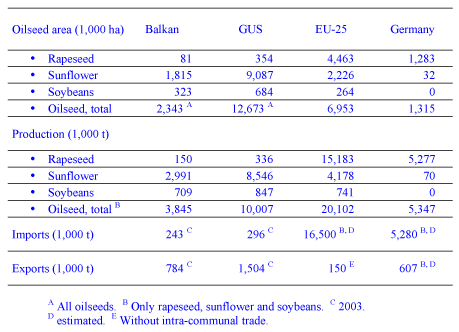The impact of rapeseed in Germany and Europe
D Brauer, M Specht
UFOP, Claire-Waldoff-Strasse 7, D-10117 Berlin, Germany
The local value of rapeseed
The rapeseed crop is of high importance for European agriculture and particularly increased its potential in the EU-25 during the last few years. In 2004 the EU-25, the Balkan States and the GUS (Gemeinschaft unabhängiger Staaten – countries formerly in the Soviet Union) together cultivated nearly 22 million ha of oilseeds (Table 1). Almost 5 million ha of this area were cultivated with rapeseed.
Today, already half of the oilseed crop production in the EU-25 consists of rapeseed, where (as in the Balkan States and the GUS) traditionally sunflower and other oilseeds (mustard seed, flax seed and cotton seed) dominate the market.
Table 1. Short overview on the area grown with oilseeds, the oil production and the import and export of oil in Europe in 2004. (Source: ZMP-Agrarmärkte in Zahlen / Mittel- und Osteuropa, 2005.)

In the EU-25 the largest producers of rapeseed are Germany (2004: 1.279 million ha), France (2004: 1.117 million ha), Great Britain (2004: 0.557 million ha) and Poland (2004: 0.538 million ha). Especially in Germany, rapeseed takes up 12% of the area under cultivation, with a planted area of 1.43 million ha for 2006. The current forecast on the cultivation of rapeseed in the EU-25 is that this upward trend will continue.
Following the record harvest of 2004, German farmers could also achieve above-average yields in 2005, which were 22% above the long-term average. One important factor of this success is the almost entire use of certified seed with the rapeseed cultivars currently in cultivation. Moreover, the locally adapted intensive method of cultivation has confirmed the agronomic skills of farmers.
In 2004 the cultivated area of more than 80,000 ha in the Balkan States has been clearly higher than in the poor year 2003. However the large scale acreage of 2001 or 2002 of more than 100,000 ha could not be reached. The increase of acreage results mostly from the cultivation in Romania which has been expanded to more than 48,000 ha. In the GUS states the cultivated area dropped from 387,000 ha to 354,000 ha. While the Ukraine doubled the amount of area (to 107,000 ha), Russia lost almost 50,000 ha and Belarus 40,000 ha.
Rapeseed oil in food and non-food sectors
In Europe, a boost of high demand for plant oils is taking place. Estimates have shown that the consumption of plant oils in 2005/2006 climbed up another 4% to 17.5 million t – after a strong increase the year before; of this, about 5.3 million t is rapeseed oil.
Strong incentives come particularly from the non-food sector, since the EU has initiated guidelines for the support of biofuels, in order to establish a proper production for biodiesel. Germany has been proven to be the leader in the field of biodiesel development. The appropriate production capacities have reached 2 million t by the end of 2005. More facilities are already in the planning stage, so that there will be a further expansion of the manufacture of biodiesel in the near future.
Moreover, the rapeseed oil for food use consists of high-quality lipid acid composition which is acknowledged by the food and nutrition industry and the consumer in general. Products derived from rapeseed oil are used frequently in a healthy diet, and they belong to the group of products with the highest growth rates in food retail sales. Therefore, it is not surprising that the production of rapeseed oil in German oil mills steers towards a new record high in the campaign 2005/2006.
Similar developments are also expected in the new EU member states and in the 19 Balkan States. The manufacture of biodiesel may result in an increasing export of rapeseed, because of growing demands in the former EU-15 states and mid-term coverage of the increasing need for biodiesel in domestic markets.
Prospects for the future of rapeseed
Forecasts predict a consistent development of the global oilseed sector. They put emphasis on the increasing demand of plant oils in human nutrition, renewable resource for biofuels and bioenergy, as well as their use in animal feed products (particularly in developing countries). As a local oilseed crop, with a high yield potential under intensive agronomic cultivation, rapeseed will be an increasing factor of economic importance in European agriculture, and the relevance of resulting products of the rapeseed crop in the food, non-food and feed industries will constantly increase.


 Union zur Förderung von Oel- und Proteinpflanzen E.V.
Union zur Förderung von Oel- und Proteinpflanzen E.V.